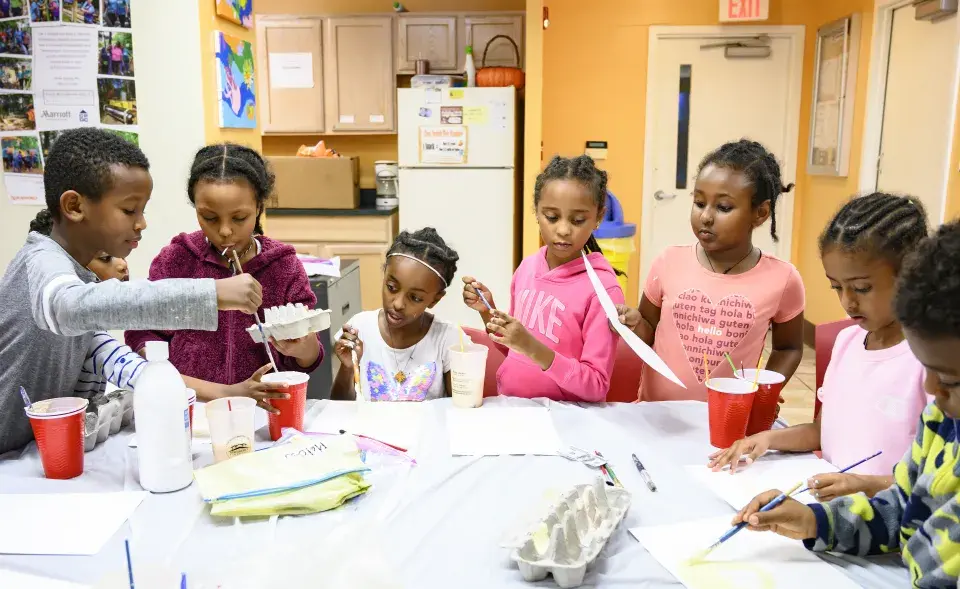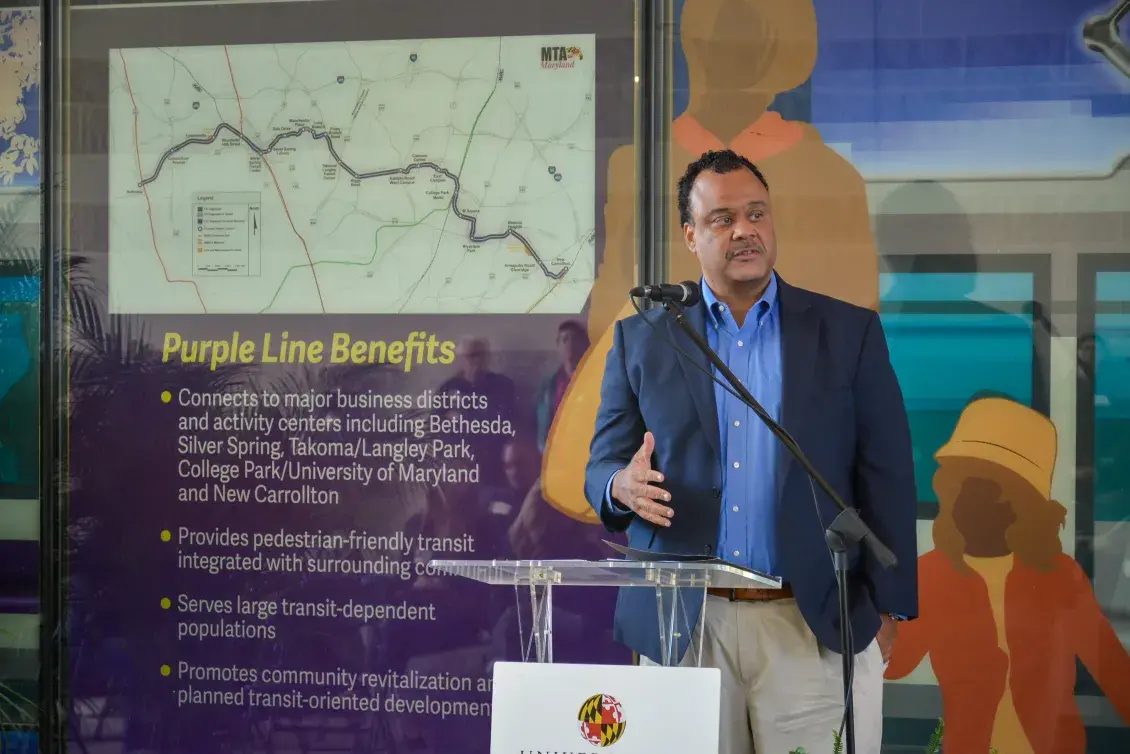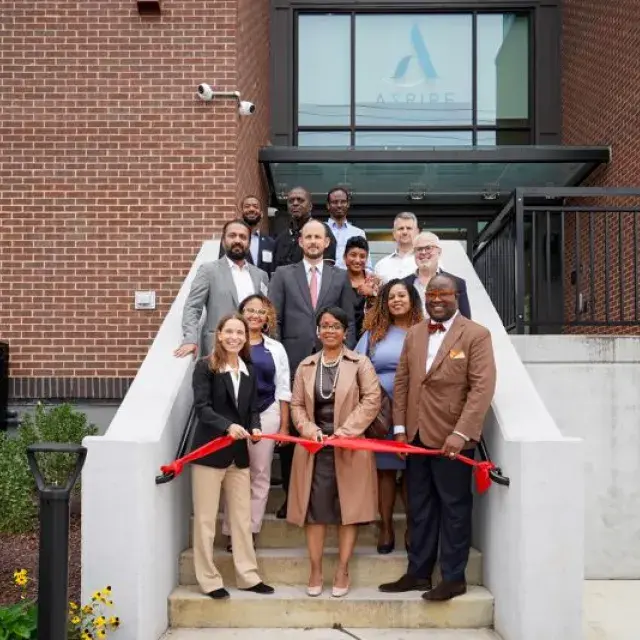At a gathering of the Purple Line Corridor Coalition (PLCC) partners last year, David Bowers, Enterprise’s vice president and Mid-Atlantic market leader, gave us all a charge: Lay track.
It’s the idea that we need to be as proactive about creating and expanding our tools for equitable outcomes for people near the Purple Line in the same way builders are laying track for the new light rail. The track we lay now will shape people’s lives and communities in our region for decades to come.
Since late 2019, Enterprise, the Latino Economic Development Center (LEDC), National Housing Trust (NHT), and other partners in the PLCC, have brought more resources to communities near the Purple Line; strengthened relationships among small businesses, mission-minded developers, and community-based organizations; and helped create more policies and resources to preserve affordable housing and small businesses in the corridor. This work was supported by a $5 million Partnership for Raising Opportunities (PRO) Neighborhoods grant from JPMorgan Chase.
Tracks Laid over the Last 3.5 Years:
- We successfully advocated for $70 million for affordable housing. Through the coalition’s advocacy, Montgomery and Prince George’s counties committed $70 million in new funds for affordable housing. This includes a $40 million Naturally Occurring Affordable Housing (NOAH) Preservation Fund and $14 million Affordable Housing Opportunity Fund, managed by NHT and integral to leveraging Purple Line Capital Pool dollars.
- We strengthened enforcement and preservation pathways for distressed properties. In response to deplorable living conditions at Bedford and Victoria Station Apartments, the PLCC released the “Two Year Roadmap,” a set of recommendations to preserve affordability and improve conditions at distressed and aging multifamily properties. The report led to the expansion of Prince George’s County’s enforcement powers and proactive rental inspections at several distressed properties.
- We helped tenants stay in their homes and learn about their rights. Our work overlapped with the end of state and federal eviction moratoriums, resulting in an uptick in eviction filings and a need for ongoing tenant outreach to help them understand their rights. Thanks to the PRO Neighborhoods grant, Enterprise was able to provide funding to CASA to support outreach and education to tenants in Prince George’s County to curb evictions. CASA helped 15 tenants access rental assistance, 17 tenants avoid evictions, and 240 tenants learn about their rights.
- We increased capacity for preserving homes near transit. Converting existing unprotected homes into committed affordable ones while maintaining the existing subsidized supply is a central part of the Purple Line Corridor Coalition’s strategy to add or protect 17,000 affordable homes for households earning $72,000 or less. Over the last three and a half years, the Purple Line Capital Pool supported preservation projects that will provide long-term affordability to more than 452 families and individuals, and in the process, increased developers’ capacity for equitable transit-oriented preservation. By participating in ongoing housing policy discussions and advocacy, we also helped reactivate Prince George’s County right-of-first refusal policy, a powerful tool for preserving multifamily rental properties.
Each piece of track is what the Urban Institute called in their evaluation of our work “durable changes that will persist long after the conclusion of the grant.” And most importantly, they will help us achieve the PLCC’s larger goals to ensure housing choices for all, support and grow local businesses, build a thriving labor market, and support vibrant, sustainable communities.

One Clear Mission: An Anchor in Uncertain Times
The PLCC’s shared goals – with a diversity of supporters – created a strong foundation to guide our work in the face of exceptional uncertainty. Right after Enterprise and our partners, LEDC and NHT, received the PRO Neighborhoods grant in late 2019, the world stopped due to a global pandemic. During the pandemic, the contractor building the Purple Line cancelled its contract, pausing the multi-billion-dollar project until the State of Maryland could replace the contractor.
Having a clear vision and goals in the PLCC’s Community Development Agreement and shared course of action in strategic plans, such as the Housing Action Plan and Small Business Strategy, kept us focused on what motivated the coalition’s formation in 2013: To ensure the Purple Line light rail supports racially and economically equitable growth.
Existing residents, many of whom are low-income and people of color, stand to benefit the most from the Purple Line. They are also the most at-risk of being displaced by escalating rents and unsafe housing conditions. The pandemic shined a brighter spotlight on their experiences, including long-standing unmet housing needs in communities near the corridor.
The risk of loss of people, small businesses, and community near the Purple Line remains very real. Decisionmakers have spent a lot of time and energy discussing the well-documented need for proactive interventions in the face of public investments like the Purple Line, including convincing skeptics that these interventions are necessary long before the impact of public and private investment are evident.
Over the last three-and-a-half years, we found that staying focused on existing residents by investing in their homes, communities, and small businesses pays off. When we lay track for them and empower them to lay track themselves, we all benefit.
This multi-part blog series highlights the impact of work by Enterprise Community Partners, the Latino Economic Development Center, and the National Housing Trust in communities near the Purple Line expansion. This work was generously supported by JPMorgan Chase through its PRO Neighborhoods initiative. Read the first blog here.

